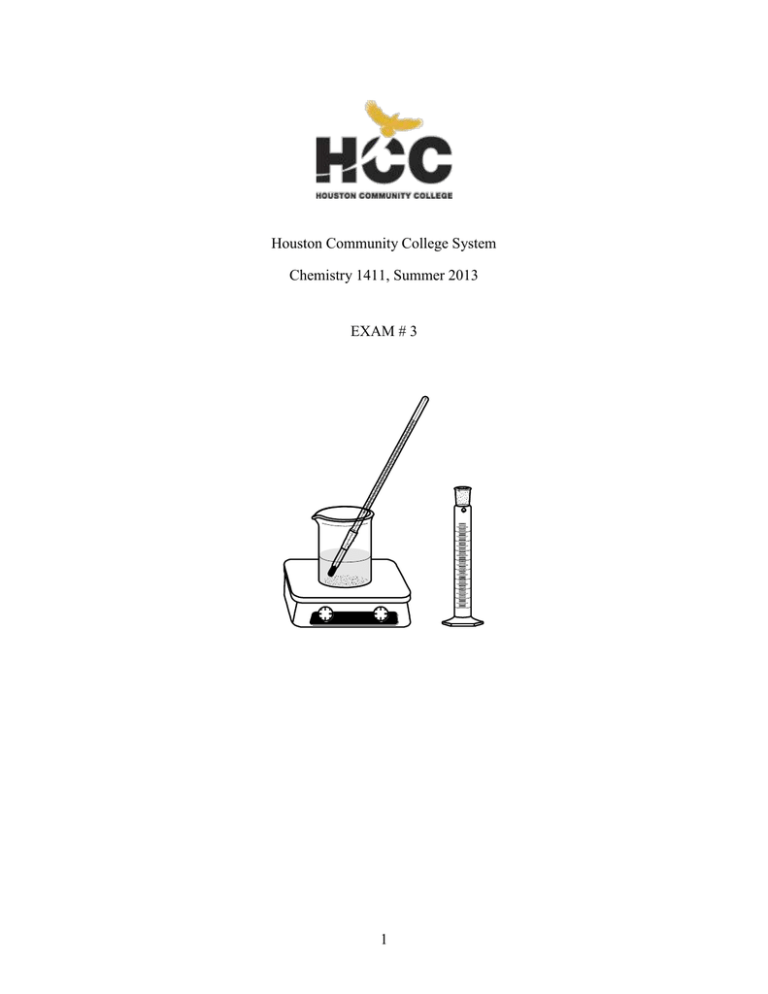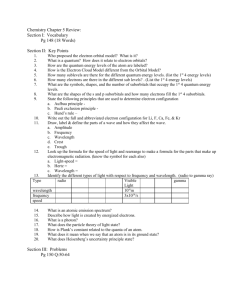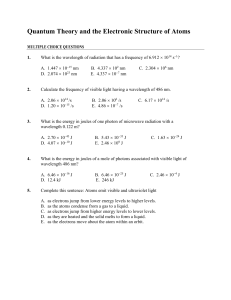exam3gc1sum13.doc
advertisement

Houston Community College System Chemistry 1411, Summer 2013 EXAM # 3 1 CHEM 1411 EXAM # 3 (Chapters 7, 8, 9, 10) Name:______________________________ Score: Directions- please answer the following multiple-choice questions next to each number. Please show all your work for bonus question and part(2) questions in the space provided. Part (1) - Multiple Choice - (3 points each) _____ 1. How many unpaired electrons are in the ground state electron configuration of Iron? A.2 B. 4 C. 5 D. 6 E.3 _____ 2. Which of the following molecules/ions is polar? A. NO3B. CO3-2 C. SO3 E. all are D. SO3-2 _____ 3. In which of the following molecules is the strongest intermolecular force hydrogen bonding? A. C6H6 B. CF4 _____ 4. Which one has the largest radius ? A. P-3 B. Br- C. C6H5NH2 D. SO2 E. KNO3 C. As-3 D. Rb+ E. Sr+2 _____ 5. Which of the following sets of quantum numbers corresponds to a 6d electron? A. n=6, l=2, ml=1, ms=1/2 B. n=6, l=1, ml=1, ms=1/2 C. n=6, l=5, ml=1, ms=1/2 D. n=6, l=3, ml=1, ms=1/2 E. all do _____ 6. What is the maximum number of electrons that can have the quantum numbers n=4, l=2? A. 2 B. 6 C. 10 D. 16 E. 32 _____ 7. Which of the following quantum number combinations is correct? A. n= 5, l=3, ml=-4, ms=-1/2 B. n= 7, l=1, ml=0, ms=1/2 C. n= 4, l=0, ml=0, ms=-1 D. n= 2, l=2, ml=-2, ms=1/2 E. All incorrect _____ 8. Which orbital does not exist A. 7p B. 3d E. all exist C. 5f D. 1p _____ 9. How many electrons in an atom can have the quantum numbers n=3, l=1, ml=-1, ms= 1/2? A. 1 B. 2 C. 6 D. 9 E. 18 _____ 10. The electron configuration of the In+3, is A. [Kr]5s24d105p4 B. [Kr]5s24d8 C. [Kr]4d10 D. [Kr]5s25d105p4 E. [Kr]5s25d8 _____ 11. What is the central N atom hybridization and the approximate bond angle in N3- ? A. sp3, 109.5o B. sp2, 120o C. sp, 180o D. sp3d, 900 E. sp3d2, 180o _____ 12. Which of the following is the electron configuration for Ni+3 ? A. [Ar] 4s2 3d10 B. [Ar] 4s2 3d5 C. [Ar] 3d7 E. [Ar]4s13d10 D. [Ar]4s13d6 _____13. Which one of the following ions has an octet of valence electrons? i. Br+ ii. Sb-3 iii. Cu+ iv. Pb+4 A. all of them B. none of them C. i & ii 2 D. iii & iv E. ii alone _____14. Which of the following electron configurations for the species in their ground state are correct? i. Ge: [Ar]4s24p64d6 ii. Y: [Kr]5s25d1 iii. V: [Ar] 4s23d3 iv. I: [Kr] 5s24d105p5 v. O: 1s22s22p4 A. All of them B. None of them C. i & ii D. iii, iv & v E. i alone _____ 15. Choose the correct order of ionization energy of the atoms, S, Si, Ge? A. S< Si < Ge B. Ge < Si < S C. Si < Ge < S D. Ge < S<Si E. Si < S < Ge _____ 16. How many dots will you place in the Lewis symbol of H+? A. 0 B. 1 C. 2 D. 4 E. 8 _____ 17. Which of the following elements is diamagnetic? A. Be B. Br C. B D. N E. O _____ 18. Which of the following atoms can accommodate an excess of 8 electrons in Lewis structures where they are the central atom? A. S B. P C. Cl D. Xe E. all of them _____ 19. Choose the compound with the lowest lattice energy: A. MgCl2 B. MgO C. CaS D. CaBr2 E. MgS _____20. Choose from the atoms listed below, the one with the lowest electronegativity A. Li B. Na C. K D. Be E. Mg Part (2) - Show all your work. ( 8 points each) 21. Use bond enthalpies to calculate the enthalpy of the reaction, CH4(g) + 2Cl2 (g)CH2Cl2(g) +2HCl. Bond Bond enthalpy (kJ/mol) C-H 416 Cl-Cl 242 H-Cl 431 C-Cl 327 22. Draw Lewis structure for ClF5 and determine a) electron geometry b) molecular geometry c) central atom hybridization d) polar or nonpolar 23. Write the quantum numbers of all electrons in the n=2 shell. 24. Consider the electron transition in the Bohr model of the H atom from the n=5 orbit to the n=3 state? a. Is light absorbed or emitted? b. Calculate the energy, frequency and wavelength in nm of the photon involved. 3 - 25. Consider the following two resonance structures of CH2CHO . a. Assign formal charges to both C’s and the O in both structures b. Pick the major structure based on the formal charges. .. :O: :O: .. || H-C-C-H | H-C=C-H | | H H Structure 1 Structure II Bonus Question: Use Molecular orbital theory to predict the following for F2 : a) Its molecular orbital configuration b) Its bond order c) Is it paramagnetic or diamagnetic? 4








